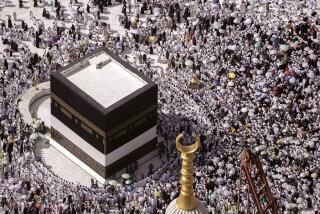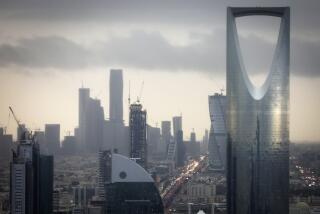Journeys to the Middle East : RUINS TO RICHES : Jordan : Exploring Ancient Mysteries in Petra
- Share via
PETRA, Jordan — Michelangelo said that when he looked at a block of marble he saw a figure trapped within it.
The Nabateans of southern Jordan were a bit more ambitious. Two thousand years ago, much before Michelangelo ever picked up a chisel, these Arabian tribesmen looked at cliffs of stone and saw an entire city.
Without drills, tractors, jackhammers or even picks as fine as the sculptor’s, they set upon the hillsides and began carving deep into them, hollowing out two-story temples propped on Corinthian columns, tombs bedecked with obelisks and statues of gods, courts, reservoirs, staircases, aqueducts and homes of stony grandeur. More than 800 examples of their towering handiwork sprawl across 36 square miles of a hidden valley in Jordan’s desert, a site that attracts thousands of tourists every year. “If you are only going to see one place in Jordan, or the whole Middle East for that matter, make it Petra,” advises one guidebook.
My uncle and I had just spent two weeks climbing around the ruins of Syria, but none of it had prepared us for Petra, the city whose name means “rock.” Just after sunrise last fall, we boarded a rickety Asia Motors mini-bus with about a dozen other visitors and, to the thumping quarter tones of Arabic dance music from the driver’s tape deck, made our way south from Amman, the capital, through 155 miles of dismal countryside, scrubby and pock-marked by electrical towers and phosphate mines. About three hours later, our cheery Palestinian driver pulled off at an overlook.
There, cutting the horizon, jagged, jutting swells of stone pushed their way up like the angry children of some prehistoric geophysical calamity. Back there, the driver told us, behind that, is Petra.
Our ears popped as we descended a corkscrew pass, passing shabby wooden signs for hotels that herald the approach to the site. At the visitor’s center, the door of the van swung open and a bird-like head poked in. “Awright, hey, who wants to see Petra?” squawked Hanny, a guide who had learned his rapid-fire English in California.
Within minutes we were calling Yullah! (“Let’s go!”) to our horses as they clopped along the needle-width, rocky gorge that is Petra’s only entrance.
*
Suddenly the gorge cracked open and flooded my eyes with pinkish light. In the break of the craggy pass, el-Khazneh, or the Treasury, rose like Atlantis uncovered, towering ahead and giving off an other-worldly glow in the late morning sun.
Petra’s signature monument, the Treasury, looms 140 feet high, with six Corinthian columns in its portico and a giant urn adorning its second story. As we stood in the shade of the soaring colonnade, Hanny told us that the 2nd-Century structure is believed to have taken 100 years to finish.
How did they do this?
Hanny had no answer to that. The Nabateans were expert architects and engineers and probably had iron tools. Yet archeologists have found no records or telltale marks of the construction techniques employed.
Why did they do this? Why dig buildings out of a stone mountainside? Because the sandstone was far more plentiful than wood, nearly indestructible, and soft enough to sculpt with relative ease. The single entrance to the site also made the city easily defensible, and the solid homes themselves offered the best protection against all torments, human and divine--wars, storms, floods, “and, of course,” Hanny said, “earthquakes.”
Around the corner from the Treasury, the Street of Facades contains a row of ancient high-rises whose entrances stand a full story above ground, protection against thieves in the days before locks.
From there, we continued on foot along the gorge, which opens into a valley of broken ground. The ground is deep with primrose- and cornflower-colored sand, and icicles of rough rock that looked as though they had dropped from the sky.
With our socks full of sand, we chased Hanny up a hill toward the Urn Tomb, so named for the funereal object that decorates its roof. From the tomb’s elevated plaza, we surveyed the hills of the Wadi Musa--the Valley of Moses--where the prophet struck the rock and drew water.
We scampered down from the tomb to the center of ancient Petra. Barely discernable were the battered remains of the grand avenue that led into it 2,000 years ago, when the city, under Roman control, was a stop on one of the major trade route from India.
Eventually, shifting routes drained away the city’s business. As Petra declined, the Romans abandoned it, earthquakes rattled it, the Muslims sacked it, and by the 8th Century, obscurity claimed it.
As we headed back in the afternoon, we felt as though we had seen so little, even though Hanny had whisked us through as much as possible on our three-hour tour.
The High Place of Sacrifice that overlooks the rocky valley was still miles away. The burial site of the prophet Aaron, Moses’s brother, and el-Deir, “the Monastery,” a building similar to the Treasury but said to be more spectacular because of its grander scale, were still many hours’ journey on horseback.
GUIDEBOOK
The Petra Portfolio
Getting there: From LAX, flights leave daily for London and New York, with connections to Amman. Round-trip via American is $1,732; via Royal Jordanian, United and TWA, $1,782.
Getting around: Buses run daily from Amman to Petra. Round-trip fare is $15; entrance to the site is $7.50. Jordan Express Tourist Transport: P.0. Box 9098, Amman; local phone 664-146.
Where to stay: In Amman, the Hotel Jerusalem International (P.0. Box 926265/6, Amman; from the U.S., telephone 011-962-6- 607-121) is luxurious at $126 for a double room. The Ramallah Hotel is clean and centrally located (Prince Mohamed St., P.0. Box 18215 Amman; tel. 011-962-6-639-551). Doubles start at $25. At Petra, decent hotels range $25-$50 a night for a double.
For more information: Jordan Information Bureau, 2319 Wyoming Ave. NW, Washington, D.C. 20008; (202) 265-1606.
More to Read
Sign up for The Wild
We’ll help you find the best places to hike, bike and run, as well as the perfect silent spots for meditation and yoga.
You may occasionally receive promotional content from the Los Angeles Times.






